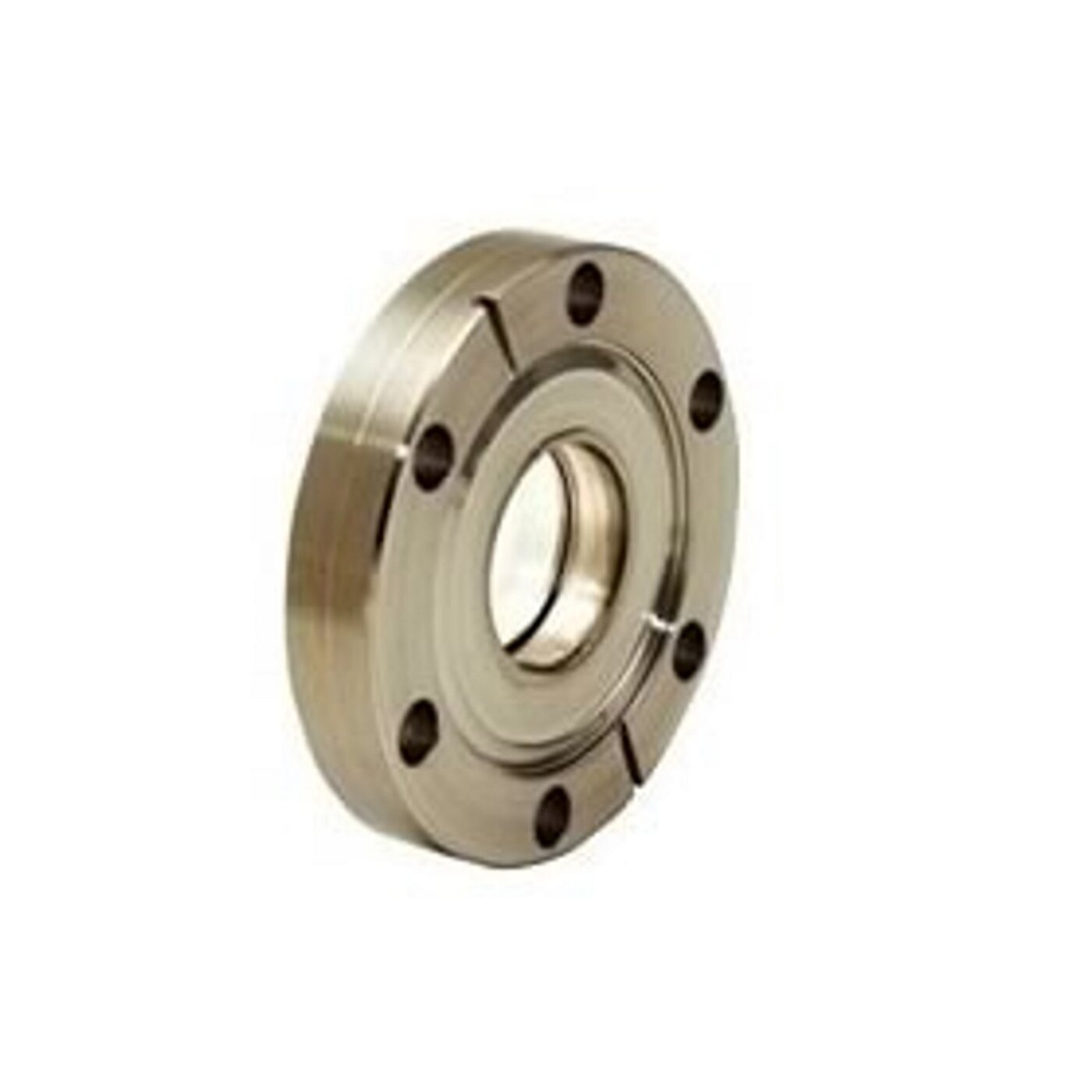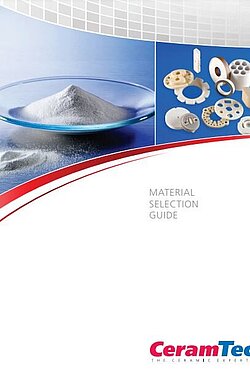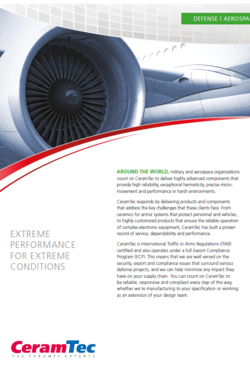Ceramaseal® Viewports
Viewports, sometimes referred to as windows or sight glasses, are optical components that provide a means for visual, optical, or broad-band energy transmission in and out of a vacuum system.
CeramTec offers two different types of Ceramaseal® viewports: zero-length viewports, which have a thickness no larger than that of the mounting flange, and tubulated viewports. Zero-length viewports have no parts protruding from the mounting flange, which makes it easier to protect from accidental damage. They also allow for the best angle of view.
CeramTec offers standard Ceramaseal® viewports in sapphire and fused silica; other materials are used for the optical components Ceramaseal® extended range viewports.


Are you interested in our products & solutions?
Go directly to our online shop.
Ceramaseal® viewports from CeramTec are precision-engineered; the transparent optical components are available in a variety of materials: sapphire, fused silica, BK7, zinc selenide, Cleartran®, magnesium fluoride, and calcium fluoride. Other viewport materials are available on request.
Ceramaseal® extended range viewports have an optical component that provides for transmission of radiation in either the ultraviolet or infrared range of the electromagnetic spectrum. Standard viewports made from either fused silica or sapphire have useful transmission from .25 to 4.0 microns. Ceramaseal® extended range viewport materials have a combined transmission range of 0.12 to 20.0 microns.
Unfortunately, no single viewport material can offer good transmission over the entire spectrum. However, alkali halides such as calcium fluoride (CaF2) or magnesium fluoride (MgF2) offer excellent transmission in the deep ultraviolet range. Polycrystalline CVD grown infrared transmitting materials such as zinc sulfide (ZnS) and zinc selenide (ZnSe) transmit radiation in the 14 and 20 microns range, respectively.

Many factors govern the selection of optical materials for the construction of a high and ultra-high vacuum assembly. Whereas quartz and sapphire can be readily metalized and sealed to vacuum flanges by brazing, most optical materials are too weak to join to by the high temperature joining processes. Further, many optically transmitting materials are strongly hygroscopic (such as sodium chloride) or melt at low temperatures (such as glass). The physical and chemical properties of Ceramaseal® extended range viewport materials have been selected on the basis of optical transmission, vacuum compatibility, strength of materials and widespread usage by optical engineers.
Zinc Selenide (ZnSe)
Best transmission available at 10.6 microns (CO2 laser fundamental line) and in the visible spectrum. It has some absorption in the blue-green range causing it to appear yellow. The index of refraction is high and thus requires anti-reflection coatings on both sides for optimum performance. This polycrystalline, CVD grown material is strong, though relatively soft compared to other crystalline, optical materials. It is non-hygroscopic. ZnSe sublimes at 300°C and reacts violently with strong mineral acids.
Cleartran® Zinc Sulfide (ZnS)
Comparable to ZnSe in most respects, only slightly more absorbing at 10.6 microns. The advantage is that transmission in the visible spectrum is better, with no absorption to only slight absorption in the blue-green range thus it appears clear (i.e. not yellow). ZnS is much harder than ZnSe and thus resists scratching much better.
Anti-reflection (AR) Coatings
AR coatings for both ZnSe and ZnS (Cleartran®) are standard and highly recommended for most applications. The exception is possibly for wide range pyrometry or spectrometry where artifacts from the coating materials leave a spectral “fingerprint” in regions beyond the useful transmission range of the coating. The standard coating has been specifically tailored to maximize transmission at 10.6 microns and will also transmit minimally 50% in the visible spectrum (i.e. remain at least partially transparent in the visible spectrum).
Calcium Fluoride (CaF2)
Best transmission by fluoride crystals in the UV range. It is relatively insoluble (non-to-very-low hygroscopic) and mechanically only slightly weaker than zinc selenide and slightly harder. It is a single crystal material with cubic symmetry, hence no birefringence. CaF2 is transparent in the visible spectrum (appears similar in color to quartz or glass) and in the UV range down to 120 nm, which makes it ideal for all excimer laser applications. It has a low index of refraction, which means that the viewports rarely require antireflective coatings.
Magnesium Fluoride (MgF2)
Next best transmission of fluorides compared to CaF2 and similar in all other characteristics with the following exceptions: MgF2 is stronger and harder and is naturally, strongly birefringent.
Standard Materials
Ceramaseal® standard viewports are also precision engineered and available in two versions: sapphire and fused silica. Other viewport materials are also available on request. CeramTec offers a UV-grade fused silica viewport with a 3.48 cm (1.37") view diameter that can be used for cryogenic applications. Sapphire viewports are manufactured using conventional metalization and brazing techniques, while fused silica viewports utilize the active-metal vacuum bonding process. Because of bonding materials used in the manufacture of fused silica viewports, it is important to note that there are corresponding temperature limitations which must be considered.
Sapphire:
- Temperature range: -69°C to 450°C
- Standard transmission range: 0.25 to 4 microns
- Internal pressure 1x10-10 torr up to 27 bar (400 psig)
- Viewport diameter between 1.40 and 4.93 cm (0.55 - 1.94")
Ceramaseal® Extended Range Viewports:
- Optics: Zinc selenide (ZnSe), Cleartran® zinc sulfide (ZnS), calcium fluoride (CaF2), magnesium fluoride (MgF2),
- Temperature range: -8°C to 204°C
- Standard transmission range between 0.12 to 20 microns
- Viewport diameter 2.79 cm
- Anti-reflective coating (optional)
Fused Silica:
- Temperature range: -65°C to 200°C
- Standard transmission range: 0.25 to 2 microns
- Internal pressure 1x10-10 torr up to 8 bar (115 psig)
- Viewport diameter between 2.87 and 9.67 cm (1.13 - 3.81")
Custom designs and solutions:
- UV grade viewports
- Double viewports
- Viewing diameters exceeding 17.78 cm (7")
- Internal pressures up to 5,520 bar (80,000 psig)
- RF applications and special configurations
- Different optics are available on request such as BK7, barium fluoride, crystal quartz, fused silica, germanium, sapphire, silicon, zinc sulfide
- Specialized coatings are available
- Higher temperature viewports are also available




